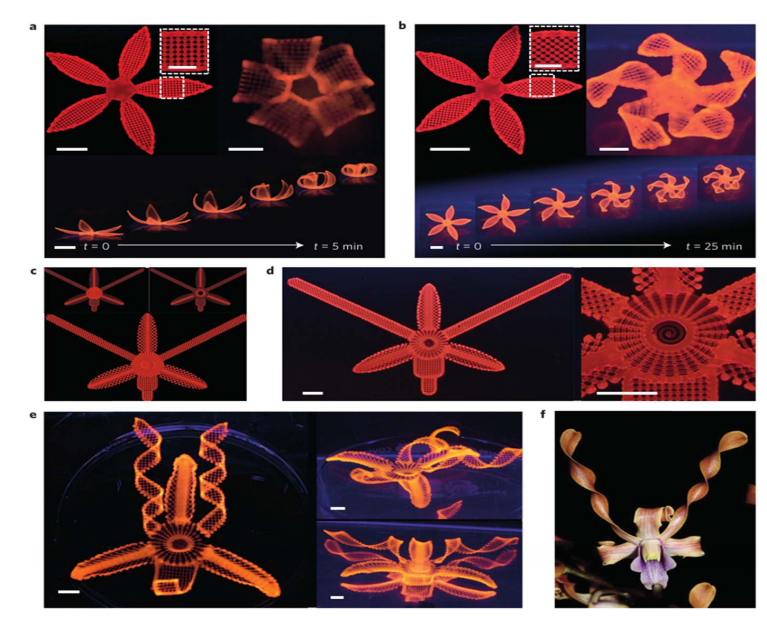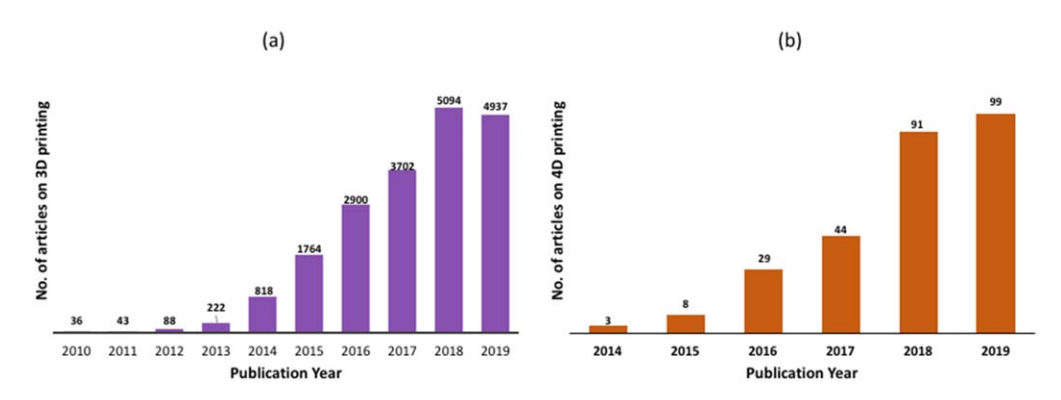Researchers from Japan and the US are filling us in on some of the latest trends in digital fabrication and materials, highlighted in the recently published ‘Review – Recent Progresses in 4D Printing of Gel Materials.’
Ascending from the miracles of 3D printing, 4D printing offers a new level of fascination as materials adapt to their environments, doing the bidding of humans as needed in a variety of applications such as soft robotics, bionic devices, and more. As the authors offer a review of the latest trends and topics in 4D printing, we also learn more about new materials—and challenges users are working to overcome.
“4D printing is based on 3D printing technology with an added dimension, where the printed structure evolves as a function of time,” explain the authors. “Materials that are stimuli-responsive are used for 4D printing such as shape memory alloys and polymers etc. Once these materials are 3D printed, they can morph into complex geometries on being exposed to external stimuli such as heat, temperature, pH etc.”
As users around the world—whether in manufacturing, research labs, or the home workshop—experiment with digital fabrication in 4D, a variety of materials are being used such as shape memory polymers, carbon fiber, and a wide range of composites. The use of gels is becoming increasingly popular too because they allow for even greater versatility in creating complex geometries, as well as some that may not have been possible before.
And while 4D printing may present a ‘radical shift’ from traditional 3D printing, there are still challenges in achieving shape transformation, as well as desired functionality. There are many expanded benefits, however, beginning with sensing and programmability features—along with better efficiency in production and assembly, greater affordability, reduction in manual labor, and more.
“Every 4D printable material is a kind of stimuli receptor or in other word sensor by which they can sense their surroundings and response according to their characteristic abilities,” stated the authors.
Both swelling and temperature control are popular ways to manipulate 4D printing materials without the need for human intervention, meaning they could be beneficial in areas of catastrophe or danger to people.
“The pioneering work on 4D printing presented by Tibbits and coworkers combined multi-material and their respective swelling properties to demonstrate 4D printing phenomena,” explain the authors in their review.
“The expandable material was cross-linked hydrophilic polymer that formed a hydrogel when exposed to water, and in the process the printed gel experienced a large volume expansion up to 200%.”
Further research was completed with a thermally responsive cross-linked network of Poly(Nisopropylacrylamide) (PNIPAAm), created by Bakarich et al. 3D hydrogels were also printed to offer shape deformation by Naficy et al. Delving further into biomimetic hydrogels, Gladman et al. created a composite meant to be 4D printed in bilayer structures, deforming when ‘soaked in water due to localized swelling anisotropy.’

(a) Deformation of a grid into a sinusoidal wave. From left to right and top to bottom, we observe the grid as it folds into the desired shape. Only angular primitives were used. (b) Deformation of a grid into a hyperbolic surface. On the top, we visualize the fabricated model and, on the bottom, the simulated version. The final deformation provides a reasonable approximation despite using only folding bars in the simulation. (c) Fabricating a time-varying curve. From left to right and top to bottom, the curve deforms over time to a different shape. Reproduced with permission.37 Copyright 2014 Springer Nature.
Huang et al. created a system with both a computer-controlled projector and a reaction cell featuring a photo-curable monomer. With a range of cross-linking densities, they showed that water immersion response varied, resulting in a shape change in materials.’
“In contrary to typical layer by layer 3D printing process, the advantage of their system lies in the introduction of stresses into a printed 2D structure through a simple and easy way,” stated the authors.

Complex flower morphologies generated by biomimetic 4D printing. a,b, Simple flowers composed of 90◦/0◦(a) and −45°/45°(b) bilayers oriented with respect to the long axis of each petal during the swelling process (bottom panel) (c), printed structure (d) and resulting swollen structure (e) of a flower demonstrating a range of morphologies inspired by a native orchid, the Dendrobium helix (courtesy of Ricardo Valentin) (f) Based on the print path, this orchid architecture exhibits four different configurations: bending, twisting and ruffing corolla surrounding the central funnel-like domain (scale bars, 5 mm). Reproduced with permission.60 Copyright 2016, Springer Nature.
Some researchers explored the use of origami-inspired structures, using bi-layers and tri-layers within one print, while others focused on thermally responsive bioimplants and continuum robots, versatile inks, and hardware too, such as an innovative 4D printer using UV curable gel materials.

(a) Printed multi-scale buckled structures. (b) 3D cartoon face mask viewed from two different angles. (c) Finite element analysis (FEA) modeling of a 3D theater. From left to right: planar printing layout, 3D theater viewed from two different angles, and the corresponding strain map scale. (d) Photographic images of actual printed 3D theater viewed from two different angles. (e) Printed 4D object, that is, 3D object with active shape changing capability. Reproduced
with permission.66 Copyright 2016 WILEY-VCH Verlag GmbH & Co. KGaA, Weinheim.

Actuation of Miura-ori origami fold pattern, containing 10 vertices, from dehydrated (left) to hydrated (right); small actuation angles (a) & (b) and
large actuation angles (c) & (d). Scale 1:0.59. Actuation of waterbomb origami fold pattern, containing 75 vertices, from dehydrated (left) to hydrated (right);
small actuation angles (e) & (f) and large actuation angles (g) & (h). Scale 1:0.47.70
“To advance the innovation in 4D printing, it is consequently crucial to incorporate rational computer designs of sophisticated multiple stimuli-responsive procedures in order to further boost its widespread implementation in building complex, self-morphing objects in mechanical engineering, soft robotics and bio-engineering field,” stated the authors.
“We believe that innovation in the material, fabrication, design and modelling will create further progress in this field. 4D printing in the biomedical field has the potential to physically enable the expansion of biology and bring organ printing one step closer to reality. So, in order to successfully apply 4D printing in practical applications, continuous progress should be made to overcome the current challenges and only then this technology will bring out its best features for the future world.”
What do you think of this news? Let us know your thoughts! Join the discussion of this and other 3D printing topics at 3DPrintBoard.com.

4D printing product printed by 4D ink: a whale like hydrogel was used as a model to schematic the 4D transition process (a), the softening and
hardening cycles of an octopus like gel (b), the storage modulus (E′) variation of 4D Gel during heating and cooling cycles measured by rheology (c).
Reproduced with permission.76 Copyright © 2018 American Chemical Society.
Subscribe to Our Email Newsletter
Stay up-to-date on all the latest news from the 3D printing industry and receive information and offers from third party vendors.
You May Also Like
3D Printing Unpeeled: New Arkema Material for HP, Saddle and Macro MEMS
A new Arkema material for MJF is said to reduce costs per part by up to 25% and have an 85% reusability ratio. HP 3D HR PA 12 S has been...
3D Printing News Briefs, January 20, 2024: FDM, LPBF, Underwater 3D Printer, Racing, & More
We’re starting off with a process certification in today’s 3D Printing News Briefs, and then moving on to research about solute trapping, laser powder bed fusion, and then moving on...
3D Printing Webinar and Event Roundup: December 3, 2023
We’ve got plenty of events and webinars coming up for you this week! Quickparts is having a Manufacturing Roadshow, America Makes is holding a Member Town Hall, Stratafest makes two...
Formnext 2023 Day Three: Slam Dunk
I’m high—high on trade show. I’ve met numerous new faces and reconnected with old friends, creating an absolutely wonderful atmosphere. The excitement is palpable over several emerging developments. The high...
































